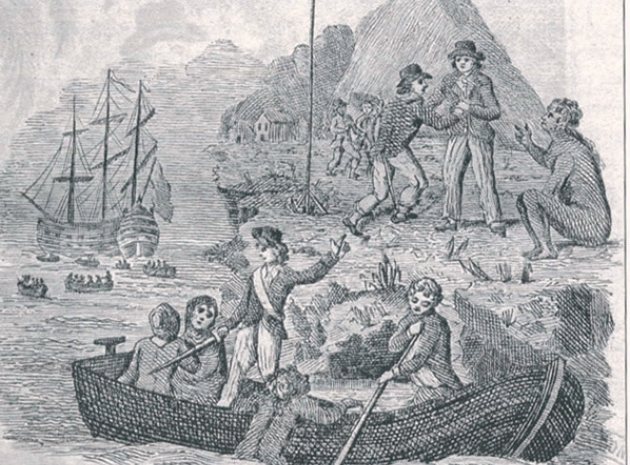Today you will…
...Take part in activities to help you understand the ‘bloody code’
• Understand which factors influenced it
• Compare levels of change and continuity over time
• Be able to access and examine primary source and archive material
At first sight, the 18th century can appear to students as one of the harshest, most bloody periods of British judicial history, especially once they are shown the well-trodden ground of the list of crimes punishable by death by the end of the century. Even the name assigned to laws of this period – The Bloody Code – evokes a sense of foreboding, but there are questions to be answered. What was the Bloody Code? What attitudes and factors led to the Bloody Code? Did it work? Compared to other periods, how ‘bloody’ was it? In this lesson, students will use archive materials to help them to answer those questions. It can serve as part of an introduction to punishment in the period 1700-1900, covering punishment in the 18th century and can be easily extended into a series of lessons examining crimes, punishments and changes.
Starter activity
Fielding’s men
Share with pupils an image and short introduction to Henry Fielding, founder of the Bow Street Runners. Then share a transcript of Henry Fielding’s feelings about law and order in London (tinyurl.com/d3sd6zs). Depending on the ability of your students you may need to adapt the transcript to enable understanding.
Q: What does this suggest about the types of crimes being committed in London and other large cities like it?
Q: What does it suggest about changes that have taken place over the last century?
Q: What does this suggest about his attitudes towards crime at this time?
Q: What does this suggest about the crime rate?
Explain to the class that it will now be their job, using contemporary evidence that will be at their disposal, to test out whether something like the Bloody Code laws might act as a suitable deterrent against law-breaking.
Main Activities
1: In the dock
By 1815 there were c.225 crimes punishable by death. Make a set of cards giving brief details of those that you find interesting (you can use as many as you like, but 10-15 will be ample to keep up a fast momentum and illustrate the point). Dish out the cards to various students. In turn, ask students with cards to stand before the court and read out their crime. The students then become the court and have to decide upon the punishment they will deal out via a vote. The four corners and other areas of the room can be set up to represent the main types of punishment at their disposal. Students should decide which punishment they think each crime deserves and send the card bearer to the relevant part of the room. Once all students have been distributed, discuss what questions and issues the students’ decisions have raised:
Q: Why did they make these decisions?
Reveal the truth that all of these crimes were punishable by death and move all of the card bearing students to the condemned cell area of the room.
Q: What problems did this kind of code bring about?
Why might some of these crimes have been punishable by death? What can this tell us about the attitudes of people making the laws and society at this time?

2: Court in session
Students should use the Old Bailey Archive (tinyurl.com/cwzg3cg) and court archives from Durham Assizes (tinyurl.com/d432mje) to investigate an example of The Bloody Code. Students will use the punishment rolls from 1786 to plot the types of crimes against the types of punishment dished out. This information can be recorded in any way you like, but a graph can provide an excellent visual guide. Students should compare the evidence of the court sentences with the types of crimes punishable by death they saw earlier and ask the following questions of the evidence:
Q: What punishments were dealt out? For which crimes?
Q: Which crimes received the death penalty?
Q: What percentage of the total listed received the death penalty?
Q: How do these death sentences compare to the crimes punishable by death that have already been seen?
3: How “bloody” was the bloody code?
There are two key issues for students to consider about the Bloody Code:
1. Did it work? Why (not)?
2. How did punishments compare to other periods?
A) Students should use the Old Bailey Archive to delve a little deeper into the crimes of 1786 (http://tinyurl.com/csd9sk). If you have plenty of time, you can extend this into a lesson in itself by teasing out some of the stories of the people involved (the case of Margaret Dawson is an interesting one to explore.) Students should use the search facility to research one single crime as an example. As theft was high priority, this is the example I like to use. Ask students to search the year 1786 for grand larceny, but each time changing the sentence that they are searching for (for ease, I ask students to click on all sub-categories for each type of punishment rather than searching each one individually). Ask them to note how many different punishments were given to the same crime and how widely these punishments varied. (Hint – if they click on calculate total, the page will tell them how many people under their search criteria received that sentence in that year)
Q What does this tell us about how consistently sentences were applied?
Q What was the most popular punishment for grand larceny in 1786?
Q Why might this have been?
B) Now split the class in half. One half of the class should access Yalding Manorial Court Records for 1334/5 (tinyurl.com/d6pyu3v) and the other half should access the Old Bailey archives and the Durham archive (tinyurl.com/cjuhpdp) once again, and search this time for the year 1836. Students should re-use their graphs that they made previously and plot the types of crimes committed against the punishments dealt out. If students are working in groups, it is a good idea to save the Old Bailey archives for more able students as by 1836, there are no punishment summaries as found in 1786, so students will instead have to carry out a statistical analysis plotting a table by offence and punishment (tinyurl.com/bpq9snj). I’ve created an example to illustrate the process, which you can find at tinyurl.com/booqudd. Students can use the data from the tables they create to interpret changes and add to their graphs.
Home learning
1. A written piece asking students to examine how bloody the bloody code was or asking students to examine why the Bloody Code did not work.
2. Further research into the punishments dealt by courts like The Old Bailey using their website and others. Can students find other court archives? Research particular cases from the years studied using the Old Bailey website. Use them to create a game relating to Crime and Punishment and the Bloody Code.
Summary
Class discussion: Remind students of the initial question: How bloody was the Bloody Code? Students should consider that it was the sheer number of crimes that carried the death penalty and the fact that many of these were petty that was the issue, not necessarily its success, being that sentences were inconsistent and that there were also a number of similarities with other periods that have not been historically dubbed in the same way. Students should also consider the factors that influenced the law making of this period. Finally, students should also put their judgments in the context of their evidence, being that they have considered only a very small sample.
Info bar
Stretch them further
There are a whole host of opportunities to stretch students further through working with archives like this. as one delves further into this fascinating archive, not only are you reminded that these are part of the life stories of real people, but also you find a real feel for the sense of the period. why not ask students to use some of the real stories from the old bailey website, plus further research to write their own historically accurate fiction or dramatic piece?
For those that are logically or mathematically minded, you might ask for a bit of additional number crunching and statistical work to be carried out over both the period in question and others, for example, the percentage of death sentences over the entire century as a percentage of the total crimes reported, the percentages of different crimes as an expression of the century total, a statistical comparison of different time periods, or combining several different variables…the possibilities are endless for the mathematics whizz and can provide the class with some excellent statistical data.
Additional resources
Historical association crime and punishment podcasts - tinyurl.com/d366377
About the expert
Mel Jones is very lucky in her role that she gets to work with experts in history education, teachers and students alike. Mel likes nothing more than seeing the students get a buzz from what they do through enquiry and using primary sources and archives.










